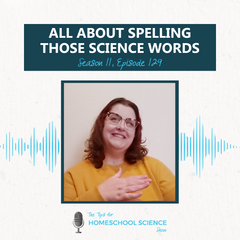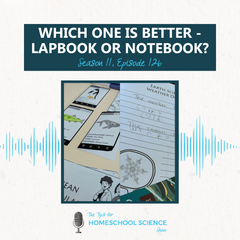FREE Shipping on all our products! (Please Note: Orders may experience a delay of a week or more in shipping due to the high volume of orders at this time of year.)
FREE Shipping on all our products! (Please Note: Orders may experience a delay of a week or more in shipping due to the high volume of orders at this time of year.)
How should you handle notebooking through the different ages? {Season 11, Episode 128}
March 18, 2024 3 min read

Welcome to season eleven of the Tips for Homeschool Science Show, where we’re breaking down the lofty ideals of writing and science into building blocks you can use in your homeschool.
In this episode, we are chatting about notebooking with different age groups!
Key Takeaway
-
Notebooking is a wonderful tool we can use to document what our students have learned in a way that is meaningful to them.
Listen to this episode
You can also listen to this podcast on iTunes, Podcast Addict, Castbox, Stitcher, or Spotify.
Share the Tips
If you found these homeschool science tips to be helpful, would you please take a moment to rate it in the podcasting app you use to listen to the show? This would help me tremendously in getting the word out so that more earbuds are filled with science-teaching encouragement.
Episode 128 - Notebooking with the different age groups
We talked a bit about how notebooking changes over the years in the previous episode with Susan and Susanna from the Well-Trained Mind. And you guys know that I think notebooking is amazingly flexible, which means that it can grow with your students.
Today, I wanted to take a moment to give you a few ideas about what notebooking can look like at the different stages.
Preschool Notebooking (00:57)
Most preschool students are not writing complete sentences. These years are really pre-writing ones. So, notebooking during this time will be very simple.
Preschoolers can easily notebook about:
- Letters, colors, and shapes;
- Books that have been read to them;
- Simple science activities they have done;
- Simple social study/history topics.
In each case, they can draw or cut out pictures to depict the topic. You may also want to have them dictate a few words or sentences to you, but it is not absolutely necessary.
In essence, the preschool notebooking page will be highly visual.
Elementary Notebooking (01:52)
Elementary students are learning how to read and write. Their notebooking pages will serve as a record of their growing skills.
- The elementary notebooking page will include the visual and material components, but how much writing will depend upon the students’ abilities. So:
- The first-grade notebooking page may only have a sentence or two that they have dictated to you;
- The second-grade notebooking page may have three or four sentences that they have dictated to you;
- The third-grade notebooking page may have one or two sentences they have written on their own;
- The fourth-grade notebooking page may have three or four sentences they have written on their own.
In short, there will be a lot of variety in the look of notebooking pages throughout the elementary years.
Middle School Notebooking (03:54)
Middle school students are learning how to organize and process information. Notebooking at this stage will be more structured than it has been in previous years.
You can do this through the use of:
- Labeled sketches or diagrams;
- Maps and timelines;
- Outlines (either single or multi-level);
- Complex narrations (i.e. one or more coherent paragraphs).
So, the middle school notebooking page will be used to show what the students have learned, and it will be used to help them process and organize that information.
When you boil it down, the middle schoolers' notebooking pages will show a high level of organization.
High School Notebooking (04:59)
Like in middle school, high schoolers will use more detailed images and complex writing tools on their notebooking pages. The difference is that their notebooking pages will also include their thoughts on the subject.
Here are a few ideas in addition to the items listed above of what their pages could consist of:
- Literary critiques of a book they read;
- Ideas on the cause and effect a certain historical event;
- How a certain passage affected them;
- Reasons for why a certain experiment turned out the way it did.
Notebooking is definitely a tool you can still use with your high school student as it can easily reflect their growing maturity.
Wrapping in Up (05:55)
Throughout the years, notebooking is a beneficial way to document what your students have learned in a way that is meaningful to them.
Preschoolers can use notebooking to visually depict the building blocks they are learning. Elementary students can use notebooking to practice their budding skills. Middle schoolers can use notebooking to begin to organize their thoughts. And high schoolers can use notebooking to communicate their opinions.
I trust that you will glean several ideas from this post on how you can use notebooking with different ages!
Also in {Podcast} The Tips for Homeschool Science Show
All About Spelling Those Science Words {Season 11, Episode 129}
March 25, 2024 7 min read

In this episode, we'll be interviewing Robin Williams from All About Spelling. Click "Read More" to listen is as we discuss tips and tricks for spelling all those science words!
Writing in Science with a Well-Trained Mind (Interview) {Season 11, Episode 127}
March 11, 2024 16 min read

Click "Read More" to listen in as Susan Wise Bauer and Susanna Jarret join Paige to share tips and tools about the third key to teaching science!
Which one is better in your homeschool - a lapbook or a notebook? {Season 11, Episode 126}
March 04, 2024 4 min read

Should you use a lapbook or a notebook in your homeschool? Click to get answers in this episode from The Tips for Homeschool Science Show.
Subscribe
Sign up to get the latest on sales, new releases and more …

